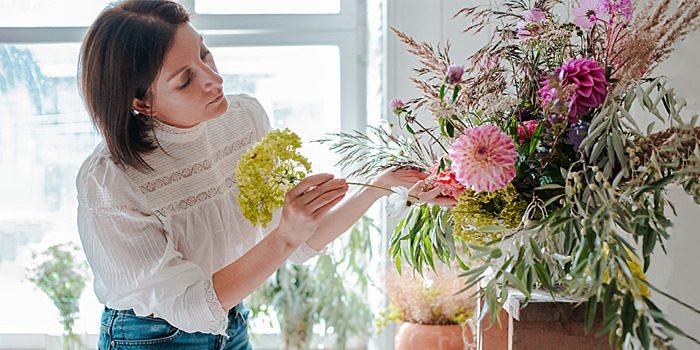If you were asked, “What’s the most creative thing you’ve done today?,” would you answer with confidence? Or regretfully question the number of creative bones you have in your body? It’s common to reserve the word “creative” for artists, deeming other professions, pursuits, and even other people unworthy of the adjective.
In the context of Ayurveda, you’ll often find the same. Certain doshas get labeled as the creative-type and specific elements—namely air and ether—tend to be more commonly associated with creative characteristics.
Yet, creativity is an expression of nature and encompasses so much more than just art.
So while it may be true that imagination, innovation, and artistry comes more naturally to some, the potential for flourishing creativity lives in everyone.
What it Means to Be Creative
How you perceive and measure your creative attributes is a direct reflection of how you define and approach creativity. A limited view could mean excluding yourself with thoughts like, “I’m just not creative” or “that activity isn’t for me.”
A more comprehensive understanding, on the other hand, leaves room for experience, experimentation, and play, and ultimately contributes to one’s holistic well-being. This perspective is supported by thoughts like, “I find having a creative outlet an important part of staying healthy.”
This expanded definition of creativity includes three categories:
- Big-C creativity
- Little-c creativity
- Companions of creativity
Big-C and little-c creativity are terms labeled by psychiatrist Mihaly Csikszentmihalyi. Companions of creativity is a component I’ve included, as I believe any creative process must have external support. As you read about these categories, think of the ways you participate in each.
Big-C Creativity
This category encompasses what’s most commonly associated with creativity—artistic masterpieces and life-changing innovations that often come just once in a lifetime or artistic achievement that’s accompanied by fame.
Big-C creativity includes culturally defining art and design that’s revered for generations, such as the Mona Lisa or Bach’s Brandenburg Concertos.
It also applies when someone dedicates their life’s work to solving a problem for society or the world, such as electricity or the internet.
This category holds a place for those with an artistic nature so strong that creating becomes as important to their life as food or water.
Big-C creativity may refer to painters with exhibits in local galleries, fashion designers making wearable art, writers touching your soul with their words, graphic designers who live for logos and typeface, or architects making models that will become a space of beauty.
Little-C Creativity
Those who create on a smaller scale, and quite frankly, those who can be dismissive of their creative abilities, will find themselves dabbling with creativity in this category.
This type of creativity is what helps you solve daily problems ranging from troubleshooting in the workplace to the workarounds you make when the right tool is lacking or when what’s supposed to work simply isn’t.
Little-c creativity also accounts for the use of art as exploration or play.
The dance or cooking class you take, the photos you snap of your cat, the meal you make and plate with care are all little-c creations.
It may not be a big and lasting event or production, but it’s a moment that you tapped into your ability to change gears, go off grid, or color outside the lines.
Companions of Creativity
The divisions of big-C and little-c are dedicated to the creative activity or final product and typically relate to the unique internal process of an individual.
The “companions” category accounts for the fact that creativity is an act that also depends on our external environment and exists for the role of community, collaboration, or communication.
This is for those working behind the scenes, having the inspiring conversations, viewing or taking in the art, testing innovations, and providing feedback.
These essential roles are reminders that creativity isn’t only for one’s self but for others to experience and interpret.
Arguably, these are things we might also drop into the little-c bucket, yet it’s worth noting that there are components of creativity that depend entirely on what’s happening outside of yourself. These types of creativity are more about how you participate than what you produce.
How Each Dosha Supports and Expresses Creativity
In Ayurveda, we most often credit the ether and air elements for our creative qualities. This has merit because the expansiveness and mobility of these two elements are largely responsible for how adept we are at generating new concepts and ideas.
Without the qualities of these elements in us and around us, we’d find our lives to be mundane and rote.
Ether and air add variety and excitement, which can easily and naturally be transmuted into inspiration.
For these reasons, vata dosha, which is comprised of ether and air, is the dosha we instinctively link to creativity. If you strongly express creative qualities, they’ll likely be attributed to your high representation of vata in your constitution.
Yet, this direct association limits us from seeing the various ways that every dosha—pitta and kapha included—expresses and bolster’s one’s creative nature. Using the comprehensive definition and categories of creativity from above, let’s take a look at how each dosha plays a role.
Vata and Creativity
As stated above, vata dosha is the catalyst for new ideas in the creative process. It opens your eyes to solutions that aren’t the typical, linear A to B route, while opening your mind to the idea of change and doing things a different way.
The characteristics of vata are undeniably vital to creativity, so it’s no surprise it shows up in all three of our categories of creativity.
In big-C, vata gives rise to the desire to design, draw, express and be in constant creation mode. It accounts for the playful and exploratory ways of little-c creativity, and its outgoing nature and inclination to connect with others make vata a companion of creativity.
Still, sometimes this airiness can be to your detriment if you can’t stay anchored enough to contain your creativity and transform it into action.
Pitta and Creativity
Some might say creativity is born out of chaos, but fiery pitta dosha proves that creativity also requires a degree of order.
Pitta is the sharp, detail-oriented dosha that has natural critical thinking skills, an appreciation for planning and organization, and a results-driven mindset.
These qualities most strongly support the daily problem-solving that happens in little-c creativity, but they are also those that allow you to aim high and think big, putting you in the running for the major innovations of big C creativity.
The presence of pitta in your constitution can make you self-motivated, more interested in working alone than in collaborating with a group. Thus, pitta least accounts for supporting roles.
Don’t rule it out though, as this dosha also likes to lead and teach—which is exactly how we find pitta showing up as a companion to creativity.
Kapha and Creativity
Kapha’s strong suit is support, which is why it leads the way as a companion of creativity. This dosha provides the qualities that make you a valued connector and collaborator, always ready to come to the aid of others.
This earthy dosha has the energy and structure to persist in your creative pursuits, keeping you grounded and tethered so that you can see your grand ideas to their fruition.
Yet, it’s this same steadiness that can stand in the way of creativity—if you aren’t open to new ideas or change, you run the risk of muting your own creative nature.
So, while kapha undoubtedly has a role in all variations of creativity, specifically in companion roles, it’s not typically billed for the major characteristics of big-C and little-c creativity.
3 Ways to Enhance Your Creativity
To tap into your creative side, it’s essential to both highlight and balance the elements and doshas that bring rise to your creative potential. Embrace these three tips to invite more inspiration and allow the creative juices to flow into your life.
1. Support your creative expansiveness with stability and routine.
Ether and air will feed your creative needs, but only if you have the fire, water, and earth to shape it.
An abundance of vata dosha can mean it’s difficult to finish creative work or that you’re too ungrounded for others to find your work relatable.
Foster the expansive qualities of vata with a change of scenery, meeting new people, and trying new things.
But don’t make it all about the ether and air! Look for ways to invite the other elements of fire, water, and earth into your life as well, be it through your daily routine, your harmonious relationships, or even a healthy and balanced diet.
2. Try something new, even if you’re not good at it.
There’s no such thing as good or bad creativity—it’s all about how you feel when you explore your creative side.
Maybe drawing isn’t in your repertoire, but that doesn’t mean you can’t have fun doing it.
Simply participating in creative activities can add refreshing energy and inspiration to your life, while simultaneously reducing stress.
Express your creativity in a way that brings you joy, and don’t write yourself off before you’ve even tried!
3. Tune into nature and embrace its flow.
If creativity is indeed an extension of nature, you have to be conscious of your connection to it—to both nature and creativity.
This includes things such as noting how changes in the weather and seasons make you feel, taking time to be outdoors, bringing nature indoors (with plants or flowers, for example), and paying respect to the rhythm of the 24–hour cycle through daily and nightly rituals and routines.
Like balanced creative flow, nature is always changing and renewing, yet also consistent and predictable.
Tapping into the creative power of the natural world can help us understand our own process of creativity and find the ease and confidence to express it.

